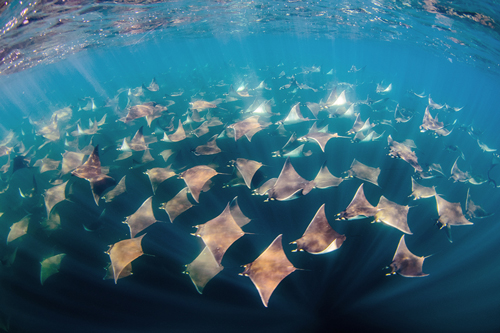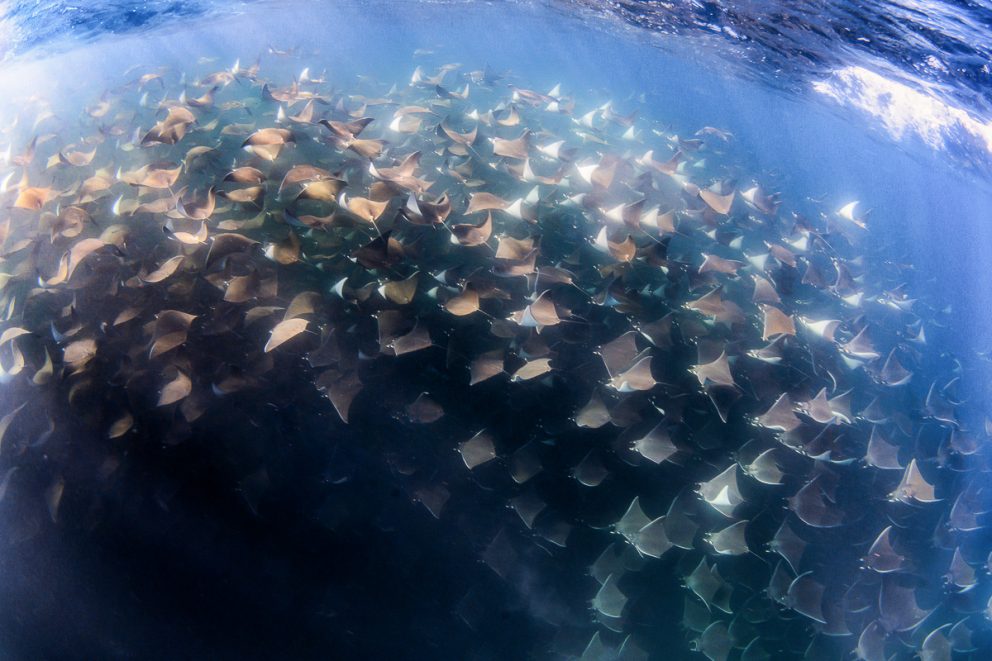It’s first light in Cabo San Lucas, the sun is rising over the entrance to the marina and a pink sky frames the open ocean inviting us to explore the deep blue sea. There are few boats out as dawn shifts into early morning and we are excited to see the calm seas ahead.
We are going to see one of Cabo’s most spectacular natural events: the schooling mobula rays.
Table of Contents :

The Mobula Munkiana aka Devil Ray
What kind of Mobulids are the flying rays in Los Cabos?
The Mobula Munkiana – Simply put; they are a type of ray that belongs to the Mobulidae family and has genetic similarities to the famous giant manta ray. They appear to ‘fly’ midwater using their pectoral fins and for this reason; some refer to them as ‘flying mobula’, but they are also often called Munk’s devil ray, Pygmy devil ray or Smooth Tail mobula. They use propulsion to launch themselves out of the water before making a large slapping noise as they crash down to the surface and this is how we find them out in the blue. More on their behaviour later!
- Family : Mobulidae
- Genus : Mobula
- Species : Mobula munkiana
- Common name:
- Munk’s devil ray
- Pygmy devil ray
- Smoothtail mobula
- Flying rays
Species description
There are records of mobula ray growing up to 5 feet long, although we see smaller ones on our Mobula ray diving tour and snorkel tours. Sometimes called Munk’s devil ray for their horn shaped lobes on the front of their head, the Munkiana mobula species that arrive in Cabo in summer are some of the smallest in the mobula family with maximum fin spans reaching only 1m; but the average is much less.
They are distinguished by their chocolate brown color on the back and their very bright white belly. Equipped with two cephalic fins on the front of their head, which they use to feed, by funneling the water to its mouth and filtering it through its gills. To move underwater they use their pointed pectoral fins like a bird to move gracefully under water. It’s impressive to see the speed they can reach in a few flaps of a fin.
- Width size : 1.1 meters (3.6 ft)
- Weight : 20 to 25 kg (45 to 55 lbs)
- Appearance : Brown to Grey color
- Reproduction : Ovoviviparous
- Lifespan : 15 to 20 years

Distribution
The Mobula Munkiana, is a highly migratory species and tends to aggregate in huge schools. They are commonly found in the eastern Pacific Ocean along the coast of Baja California in Mexico up south to Peru. It’s common to spot the Pygmy Devil rays in the Sea of Cortez but sometimes also way offshore near the Galapagos, Cocos or Malpelo islands. Due to their predictable migration route, the Gulf of California has now become a world famous destination for swimming with those rays. It’s often said that Cabo San Lucas is the best place to dive with the mobula rays.
Conservation status
The Mobula munkiana are listed as vulnerable in the “IUCN Red List of Threatened Species”. Nowadays the population trend of Mobula rays is decreasing due to fishing which is its main threat, even despite the fact that conservation and management measures are taken.
Mobula conservation : How to make a difference ?
While joining our eco-tour you will help the Mobula rays conservation efforts by becoming a citizen scientist. Working alongside the The Mobula Conservation Project you will be invited to report back the numbers, locations and behaviour of the rays.
Why the Devil Rays migrate in Baja California?
Much is still unknown about the mobula rays of Baja California Sur and their behaviour patterns, although the Mobula Conservation Project is making moves to study them in great detail and have even found nursery grounds further north.
Their visits coincide with the upwelling that maximises in April – June which pushes zooplankton up into our waters. So maybe their behaviour is also a feeding frenzy. (Source : nature.com).
The best months to reserve a Mobula Snorkeling tour is June and July although we do start to see groups in mid-May or as late as mid-August. Come and witness the massive aggregation of mobula rays that can reach several thousand individuals around Cabo San Lucas during their migration to the Gulf of California.
Swim with Mobula Ray
Scuba diving with Mobula Ray
Mobula Ray Safari : Jacques Cousteau island
Behaviour : Why the Mobula jump out of the water
We know they have arrived in Cabo when we observe them ‘popping’ from the surface like popcorn, making huge slapping noises as they belly flop down onto the surface. This causes a large sonic boom underwater and this is highly speculated to be a form of communication to others: either to attract the attention of a mate, or signal to others where the squadron is heading for safety in numbers.
They can jump as high as 6ft out of the water and even do a number of flips on the way down. Research made in Jacques Cousteau Island in La Ventana is currently being done into their aggregating behaviour. Some theories favour the idea that they are ridding parasites from their skin while others say that this is part of a mating ritual. It could purely be accidental considering the mobula ray’s only form of defence is speed and agility.
On the other hand, maybe they just jump because they are happy!

When encountering the Mobula Rays in Cabo San Lucas ?
Every summer Cabo enjoys the arrival of impressive schools of mobula rays traveling in their hundreds of thousands. Huge schools congregate at the surface where snorkelers can see them spinning, gliding and breaching out of the water for reasons that leave the scientific community baffled in awe.
In June to August the visibility is reduced but this is the time of year when we have the amazing mobula ray aggregation. Right in the bay you can be swimming with thousands of schooling mobula ray: cousin the the more famous manta ray that can be spoted in Cerralvo Island.
Mobula Ray Season in Cabo
The Mobula ray migration occurs from late May to August in Baja California. Although June and July are the best months to swim with the devil rays in Cabo San Lucas.
Seeing such a remarkable number of mobula rays is thrilling and a once in a lifetime opportunity. Snorkelers and free divers can treat themselves to one of nature’s great events on a short tour from Cabo. Don’t miss out!

Mobula vs Manta what is the difference ?
Even though they look kind of the same, Mantas and Mobulas are different species from the Mobulidae family. They can be easily distinguished by their size, color, pattern and distribution.
The Mobulidae family count no less than 11 species scattered across the globe, and have for a long time been divided into 2 main genus: the “Mobulas” and the “Mantas”. But recent DNA analysis shows that those two genera share more than we used to think, and today are gathered in the same group – The Mobula genus. Even if we still often categorize them under two different species, Manta rays are nothing less than a giant species of Mobula rays.
Mobula Rays species :
- Munk’s devil ray (Mobula munkiana)
- Longhorned mobula (Mobula eregoodootenkee)
- Lesser devil ray (Mobula hypostoma)
- Spinetail mobula (Mobula japanica)
- Shortfin devil ray (Mobula kuhlii)
- Devil fish (Mobula mobular)
- Lesser Guinean devil ray (Mobula rochebrunei)
- Chilean devil ray (Mobula tarapacana)
- Bentfin devil ray (Mobula thurstoni)
Manta Rays species :
- Reef manta Ray (Mobula alfredi)
- Giant oceanic manta ray (Mobula birostris)
- Caribbean Manta Ray (Mobula birostris) – not yet officially defined
Wish to experience the Mobulas migration in Baja California ?
Tours usually run from May to August when large schools are more predictably seen.
Dive & Snorkel with a Mobula Ray
Mobula ray : Jacques Cousteau Island














